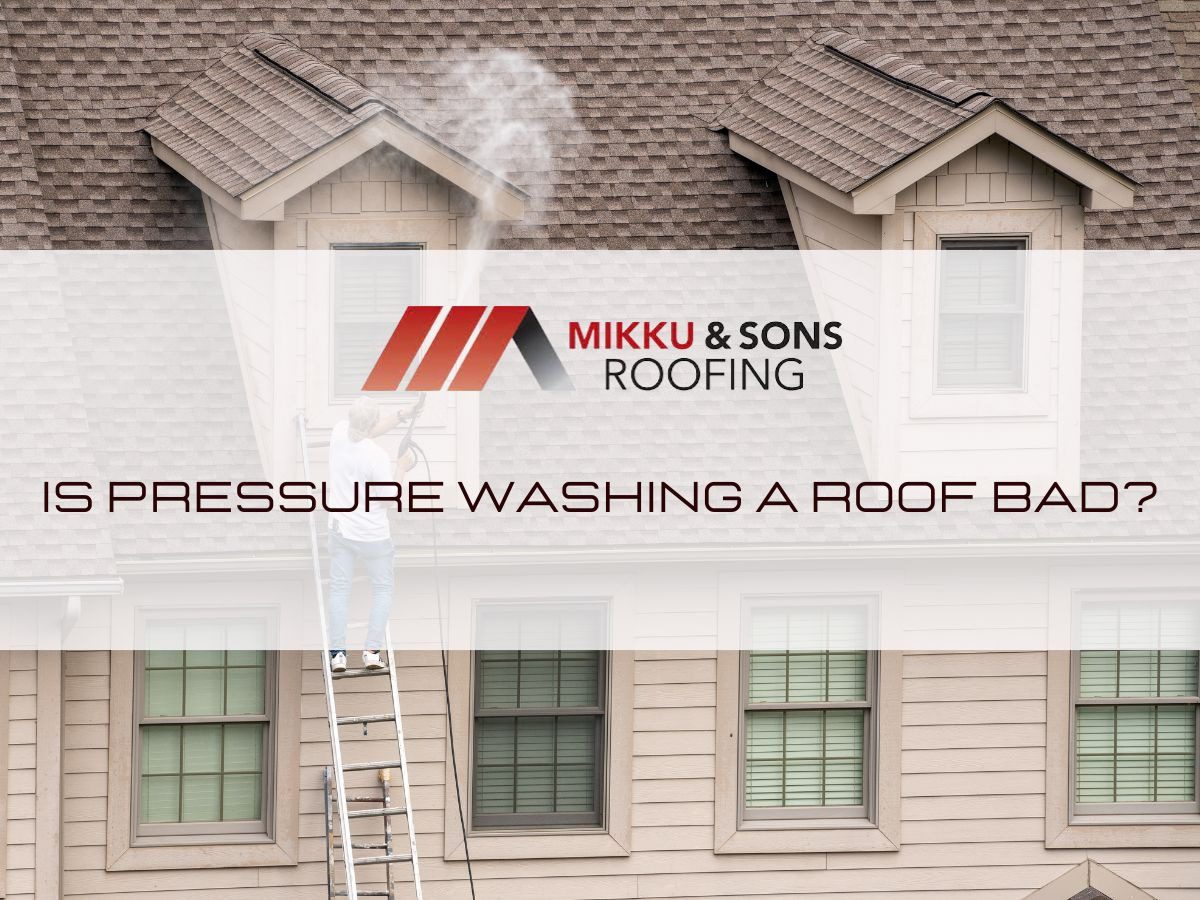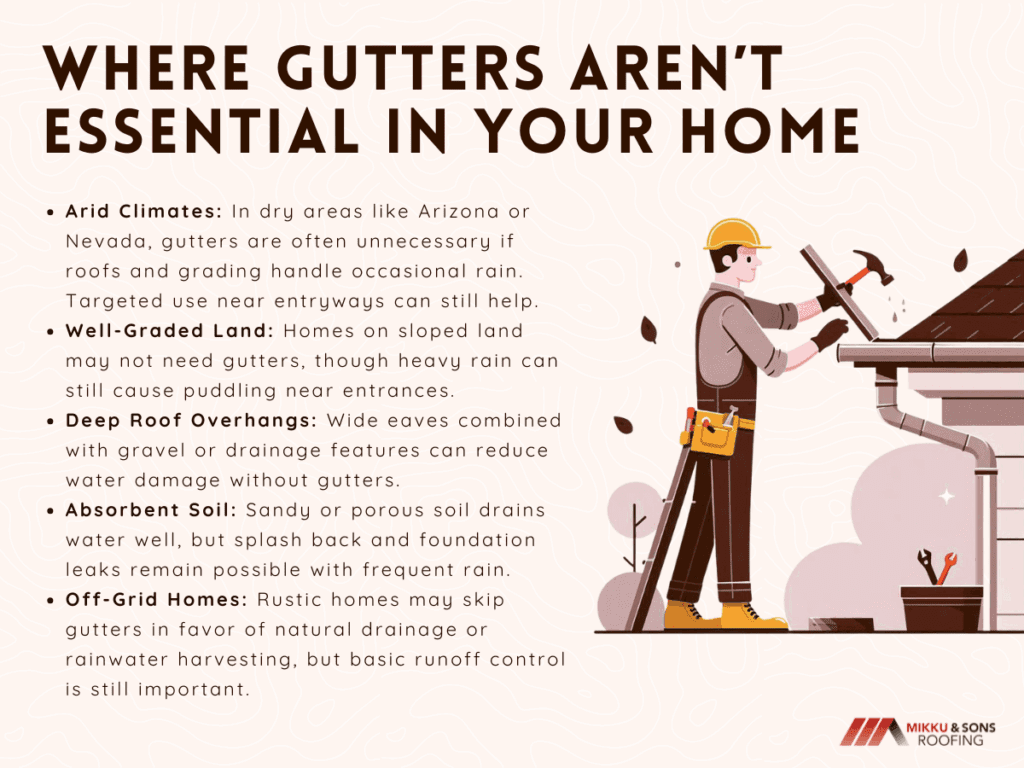

Gutters are one of those features homeowners often install without question, assuming they’re essential for every home. But that’s not always the case. While gutters play an important role in directing water away from your foundation and protecting siding, there are specific situations where your house might function just fine without them.
This blog explores real-life cases when are gutters not necessary, how to tell if your home qualifies, and what to consider before opting out. Let’s take a deeper look at when gutters are more of an optional feature than a critical one.
Before exploring when gutters aren’t needed, it’s worth understanding what they actually do. Gutters aren’t just decorative, they serve to control rainwater runoff and direct it safely away from your house. Without gutters, heavy rainfall can erode the soil, damage siding, flood basements, and compromise foundations.
In areas with frequent storms, they help protect entryways, flower beds, and walkways. In colder climates, properly installed gutters also prevent ice dams from forming at the roof’s edge.However, not all homes are affected by water in the same way. The effectiveness of gutters depends heavily on your location, roof design, ground slope, and even the type of soil around your house.

In areas like Arizona, Nevada, and parts of New Mexico and southern California, rain is so infrequent that traditional gutter systems offer limited value.
In climates where annual rainfall is minimal and flash flooding is rare, gutters may not be a practical necessity. In places like Phoenix or Las Vegas, homes are often built with minimal roof overhang and may include ground grading that naturally directs water away from the house. Many roofs are designed to shed the occasional rain directly onto gravel or concrete pads that help manage water without the need for downspouts.
That said, sudden monsoons or intense seasonal rains can still cause localized pooling if the home isn’t well-designed. Even in the desert, some builders choose to add gutters as a protective layer especially around high-traffic entry points or patios.
So if you live in a low-rainfall zone, check your roof’s pitch and drainage setup before skipping the gutters entirely. They might still be useful in targeted spots.
One of the strongest arguments against needing gutters comes down to landscaping and topography. If your home sits on land that naturally slopes away in all directions, you may not need gutters to manage water runoff. Well-graded soil allows rainwater to flow away from the house without pooling near the foundation. This setup is common in rural properties or hilly areas where homes are elevated above the surrounding terrain.
For instance, in parts of the Midwest or Appalachia, older farmhouses are often gutter-free because of the way they’re situated. Builders used to rely on simple grading, deep eaves, and gravel perimeters to keep water away from basements.
However, even with a perfect slope, you’ll want to observe how water behaves during heavier rains. Puddling near doorways or garage thresholds is a clue that gutters might still be worth adding in select areas.
Some home designs are built to let water fall naturally away from the structure, using roof overhangs to their advantage.
If your home has deep eaves that extend beyond flower beds, walkways, and the foundation, gutters might not be necessary. Traditional southwestern-style homes, Japanese architectural designs, and even certain Craftsman bungalows are known for their extended rooflines.
The wide overhang keeps rain from splashing onto walls or seeping into window frames. Combine that with gravel trenches, concrete borders, or porous soil, and you’ve got a passive drainage system.
But this only works when overhangs are paired with other water-dispersing features. If your roofline ends right above flower beds or bare dirt, water damage could creep in over time. Also, longer eaves don’t help much if the ground underneath slopes back toward the house.
The type of soil around your home matters more than most people realize.If you live in an area with sandy, porous, or well-draining soil, you may not experience the typical runoff issues that require gutters. Sandy soil tends to absorb water quickly and allows it to disperse downward without creating surface puddles.
This is common along parts of the Gulf Coast, certain areas in Florida, or even parts of the Carolina coastline. Homes built on well-drained lots in these regions may be fine without gutters, especially if combined with sloping terrain.
But keep in mind, absorbent soil doesn’t mean floodproof. Water can still find its way through foundation cracks or cause rot in wooden siding if it's allowed to splash unchecked. Consider how much rainfall your region receives annually and whether high water tables are a concern.
Many off-grid homes and rustic cabins in the United States are built intentionally without gutters. In self-sustaining or remote properties, gutters may be skipped due to simpler design goals, reliance on natural drainage, or water harvesting methods. For example, some log cabin owners allow roof runoff to fall directly into rock trenches or custom rain gardens. Others use rain chains or collection barrels without a full gutter system.
These choices are often tied to lifestyle preferences and environmental values. Owners may prefer natural erosion over artificial piping, especially if they’re not dealing with stormwater regulations or neighborhood codes.
Still, it's important to think long-term. Even a remote cabin benefits from having water directed away from the entry door, especially in spring snowmelt or autumn rains. If you're skipping gutters in these homes, at least reinforce drainage paths with gravel, stone, or French drains.
Even if you live in one of the above scenarios, there are still signs to watch for if you decide to go without gutters. Water has a way of finding the weak spot. Skipping gutters doesn’t mean skipping drainage, it means managing it in other ways. Watch for these red flags:
Water that pools even a few inches from your foundation can, over time, lead to cracks, shifting, or mold inside the basement or crawl space. Even if you have absorbent soil, too much water in one place can create problems.
If water runoff from the roof carves out channels in your garden or causes mulch and topsoil to wash away, that’s a strong clue that gutters (or at least splash guards) would help. Landscape erosion doesn’t just look messy it exposes roots and can damage your home’s curb appeal.
Look for signs of water streaks down siding or rotted trim near windows and doors. Over time, repeated water exposure can ruin paint and allow mold or mildew to spread. Deep eaves help, but they’re not always enough, especially in windy storms.
A slippery green walkway means that runoff is consistently falling in the same spot and not drying out fast enough. This creates safety hazards and long-term concrete damage.
If you're not installing gutters across the entire roofline, you can still take selective measures to manage water effectively.
Spot treatments like rain diverters, French drains, and gravel trenches can handle localized runoff without installing full gutters. These alternatives are often more cost-effective and lower maintenance than a full aluminum system.
These are metal strips installed on the roof to redirect water away from entry doors or windows. They're ideal for places with short bursts of rainfall and help keep thresholds dry.
A decorative and functional choice, rain chains replace downspouts and guide water into barrels, basins, or gardens. They work best in moderate rainfall zones and can be used in combination with partial gutters.
Simple but effective. By lining the ground with gravel or concrete splash blocks under the eaves, you help dissipate water energy and reduce erosion. Just be sure the trench has a downward slope away from the house.
These are underground systems that collect surface water and carry it away from critical zones. They’re ideal for homes built on clay or silt-heavy soil and work well even without gutters.
Even if you don’t need gutters everywhere, there are certain areas of your home where they’re always worth considering.
Over driveways, entrances, and decks, gutters help protect not just your house but your comfort and safety. Nobody likes stepping into a puddle or having icy runoff drip onto the walkway in winter. Gutters here do more than preserve structure; they protect people.
Also, local building codes and HOA rules might require you to install them. In certain flood-prone zones or city areas with water management ordinances, you may need to prove that runoff is being directed appropriately.
If you’re unsure, consult a local contractor or building inspector. They can help determine if your home qualifies as a no-gutter home or whether you’d be better off with at least partial coverage.
While gutters are standard on many American homes, they aren’t always mandatory. If your home sits in a dry region, on well-graded land, or uses thoughtful architectural features like deep overhangs and gravel trenches, you might safely skip them.
Choosing whether or not to install gutters comes down to understanding how water behaves around your specific home. Observe how your property handles rainfall, look for signs of erosion or damage, and be honest about your long-term maintenance goals. You may discover that selective drainage measures or partial gutter systems are all you need to keep your home safe and sound.
When gutters aren’t necessary, it doesn’t mean drainage isn’t important. It just means your home might be built to manage water in more natural or minimal ways, something worth appreciating when it works well.
